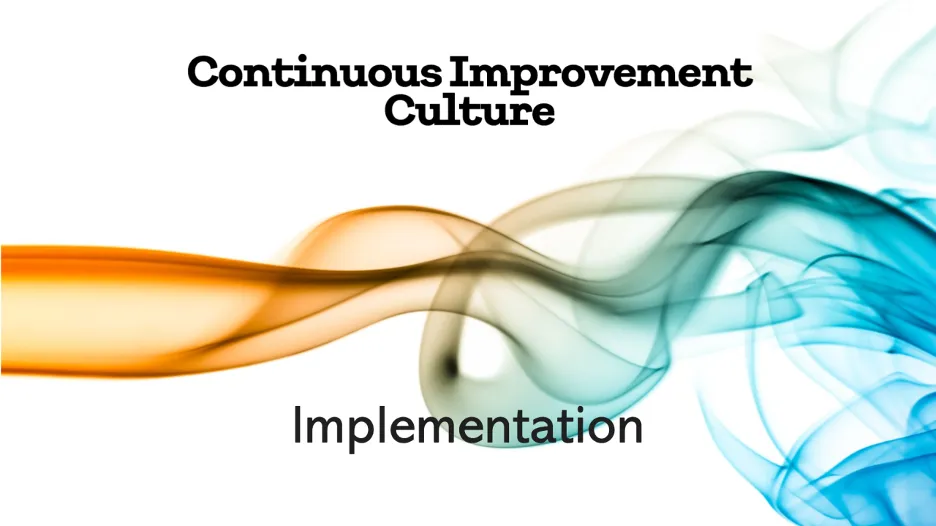
Implementing Continuous Improvement: Practical Tips for Operational Excellence (Part 4 of Our Series)
September 6, 2024
Implementing Continuous Improvement: Practical Tips for Operational Excellence (Part 4 of Our Series)
In the final installment of our series on continuous improvement, we focus on how to turn theory into practice. Continuous improvement is not a one-time effort but a strategic process that requires deliberate actions and consistent commitment across the organization. Here are some practical tips to help you successfully integrate continuous improvement into your organization's culture and operations:
1. Foster a Culture of Openness and Collaboration
To create an environment where continuous improvement thrives, begin by fostering a culture of openness and collaboration:
Encourage Open Communication: Make it safe for employees to share their ideas, suggestions, and feedback. Establish channels for open dialogue across all levels, such as regular meetings, anonymous suggestion boxes, and online platforms.
Promote Cross-Functional Collaboration: Bring together teams from different departments to work on improvement initiatives. This diversity of perspectives can lead to innovative solutions and strengthen a shared sense of purpose.
Recognize and Reward Contributions: Acknowledge and celebrate improvements, no matter how small. Recognition can be in the form of rewards, public appreciation, or professional development opportunities, which motivate ongoing participation.
2. Establish Clear Goals and Metrics
Define specific objectives for continuous improvement efforts and ensure they align with your strategic goals:
Set Measurable Metrics: Use Key Performance Indicators (KPIs) to track progress. Metrics should be specific, quantifiable, and relevant to the organization's objectives.
Communicate Goals Consistently: Regularly communicate these objectives and metrics throughout the organization to ensure everyone understands the targets and their role in achieving them.
3. Implement Effective Feedback Mechanisms
Feedback is vital for continuous improvement. Develop formal and informal ways to gather input:
Create Structured Feedback Loops: Implement processes for collecting feedback, such as surveys, suggestion boxes, or regular team meetings. Make it easy and accessible for employees to provide their input on processes, products, or services.
Act on Feedback Quickly: Show that feedback is valued by acting on it promptly. When employees see their suggestions leading to change, they are more likely to continue contributing.
Use Feedback to Drive Improvement: Regularly analyze feedback to identify patterns and areas needing attention. Adjust strategies and processes based on this information in real-time.
4. Leverage Real-Time Data and Analytics
Data-driven decision-making is at the heart of continuous improvement:
Invest in Data Analytics Tools: Use tools that provide real-time insights into operations, customer behavior, and market trends. Quick access to data allows for more informed decision-making.
Monitor Key Metrics Continuously: Regularly review key metrics to identify trends and areas for improvement, allowing for proactive adjustments rather than reactive responses.
Use Data to Inform Strategy: Base strategic decisions on data-driven insights to ensure changes are targeted, effective, and aligned with organizational goals.
5. Empower Employees to Take Initiative
Encourage employees to take ownership of the improvement process:
Provide Training and Resources: Offer training programs focused on problem-solving, innovation, and process optimization. Equip teams with the necessary skills and tools for continuous improvement.
Encourage Experimentation: Allow employees to experiment with new ideas and approaches. Encourage them to test and iterate, even if it means learning from failures.
Give Ownership of Improvements: Empower employees to own the improvement process. When they have the autonomy to make changes, they are more engaged and motivated to contribute.
6. Create a Structured Improvement Process
Adopt proven methodologies and establish a dedicated team to coordinate efforts:
Adopt Proven Methodologies: Use methodologies such as Lean, Six Sigma, or Kaizen to provide a structured framework for continuous improvement.
Develop a Continuous Improvement Team: Form a team responsible for coordinating and driving improvement efforts across the organization. Include representatives from various departments to ensure diverse perspectives.
Schedule Regular Review Meetings: Hold regular meetings to review progress, discuss new ideas, and assess ongoing projects, helping maintain momentum and accountability.
7. Encourage Leadership Involvement
Leaders play a crucial role in fostering a culture of continuous improvement:
Lead by Example: Leaders should actively participate in and champion continuous improvement initiatives, demonstrating their commitment to the process.
Provide Clear Direction and Support: Ensure leaders understand the organization's goals and provide them with the resources and authority needed to drive improvement efforts in their teams.
Foster a Learning Mindset: Encourage leaders to adopt a learning mindset, viewing challenges as opportunities to learn and grow rather than as setbacks.
8. Integrate Continuous Improvement into Daily Operations
Make continuous improvement a part of daily routines and practices:
Incorporate Improvement Activities into Daily Operations: Encourage teams to regularly reflect on their work and identify areas for improvement. Use daily stand-ups, meetings, and operational reviews to discuss improvement opportunities.
Use Visual Management Tools: Utilize tools like dashboards, process maps, or visual boards to track progress and make continuous improvement visible to everyone in the organization.
Document and Share Learnings: Create a repository where improvement ideas, case studies, and best practices are documented and shared across the organization.
9. Focus on Incremental Changes
Start small and build momentum over time:
Start Small and Scale Up: Begin with small, manageable changes that are easy to implement and measure. Once successful, scale up to larger initiatives.
Prioritize Quick Wins: Look for quick wins that provide immediate benefits and build confidence for more significant changes.
10. Continuously Review and Adapt the Process
Stay flexible and adapt to changing conditions:
Regularly Assess the Improvement Strategy: Periodically review your strategy to ensure it remains effective and aligned with organizational goals. Be open to making adjustments as needed.
Stay Agile and Adapt to Change: Encourage a flexible approach that allows the organization to adapt quickly to market conditions, customer needs, or internal challenges.
Commit to Ongoing Improvement: Recognize that continuous improvement is an ongoing effort that requires sustained commitment. Keep looking for ways to refine and optimize processes.
Conclusion
By following these practical tips, you can successfully implement continuous improvement in your organization, driving operational excellence and achieving sustained growth. Remember, continuous improvement is about creating a culture where everyone is engaged in making things better every day.
Stay committed, stay agile, and keep the momentum going! 🚀
#ContinuousImprovement #OperationalExcellence #Leadership #BusinessGrowth #Lean #SixSigma #Kaizen #EmployeeEngagement #Innovation #DataDriven
